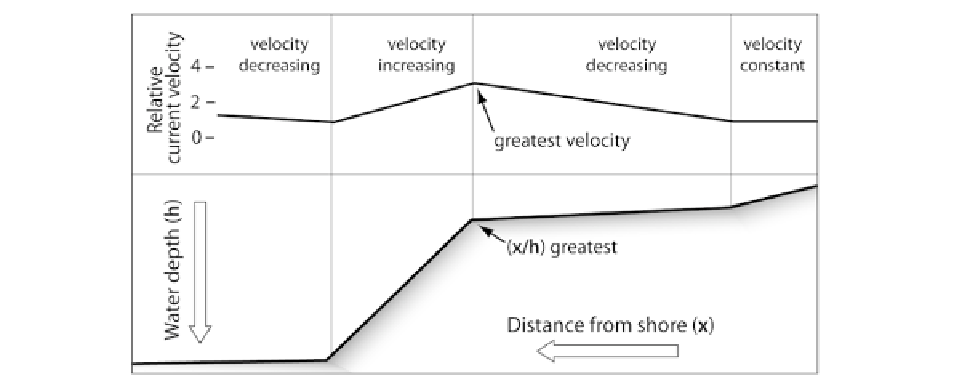Geology Reference
In-Depth Information
Fig. 13.3
Hypothetical distribution of depth-averaged current
speed along a transect perpendicular to a shelf margin. As the
tidal wave passes onto the shelf, reduction of the cross-sectional
area creates an increase in the current speed. On the shelf,
friction in shallow water reduces the tidal-current speed. The
result is a zone of maximum current speed near the shelf edge
(After Fleming and Revelle
1939
)
13.2.1 Modification of the Oceanic
Tide on the Shelf
Fig.
13.2
), and a secondary flow that is parallel to the
crests and troughs that results from the rotation of the
tidal wave. As a consequence, the tidal-current direction
at each point in an amphidromic system rotates over a
tidal cycle, creating a
tidal ellipse
that traces out the
path taken by the tip of successive current vectors. The
fastest tidal currents in each tidal cycle (i.e. the major
axis of the tidal ellipse) are nearly perpendicular to the
co-tidal lines. The propagation direction of the tidal
wave and the associated currents are essentially paral-
lel the coast. In river mouths, by comparison, the tidal
wave propagates up the river as a standing wave, so
that the currents are approximately perpendicular to
the nearby coast. On continental shelves, the peak
flood and ebb currents are commonly not parallel,
because the cotidal lines are not symmetrically distrib-
uted within each amphidromic cell, due to the unequal
speed of migration of the incoming and outgoing tidal
waves (Fig.
13.2
).
Where the tide is channelized in a seaway that is
much narrower than the radius of the amphidromic
cell, the cotidal lines become nearly parallel with each
other and are approximately perpendicular to the
seaway axis. As a result, the amount of rotation of the
currents decreases and they can even become rectilin-
ear. This is the case for the English Channel: the tidal
ellipses are greatly elongated and the peak currents are
more or less parallel to the direction of travel of the
tidal wave and essentially reverse by 180°.
The amplitude of the tide in deep oceanic waters is
commonly less than 1 m. It increases and, conse-
quently, tidal-current speeds increase, as water depth
decreases at the continental margin. This is easily
calculated with basic formulae of wave theory
(Fig.
13.1b
). However, as the tide progresses into shal-
lower water further onto the shelf, frictional dissipation
of tidal energy at the sea bed becomes important.
Consequently, an area of maximum tidal-current speed
is developed near the shelf edge (Fig.
13.3
), largely
because the tidal prism (i.e., the volume of water passing
any point during each half tidal cycle) is greatest near
there. The enhancement of tidal currents in this area
may also be due to the presence of internal tides that
occur along density interfaces in the ocean and break as
they impinge on the continental slope (Legg and
Adcroft
2003
; see Chap. 14). Internal tides are generally
important in a zone only a few tens of kilometers wide
on the outer shelf and decrease in importance toward
the coast. The best studied example is on the outer
shelf of the Western Channel Approaches, seaward of
the English Channel, where an internal tide is recorded
during summer spring tides as brief and pulsed current
surges that account for up to 40% of the total current
measured near the sea floor. The currents generated by
the combined action of the surface and internal tides

